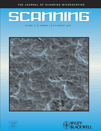Fabrication of nanodot plasmonic waveguide structures using FIB milling and electron beam-induced deposition
Abstract
Fabrication of metallic Au nanopillars and linear arrays of Au-containing nanodots for plasmonic waveguides is reported in this article by two different processes—focused ion beam (FIB) milling of deposited thin films and electron beam-induced deposition (EBID) of metallic nanostructures from an organometallic precursor gas. Finite difference time domain (FDTD) modeling of electromagnetic fields around metallic nanostructures was used to predict the optimal size and spacing between nanostructures useful for plasmonic waveguides. Subsequently, a multi-step FIB fabrication method was developed for production of metallic nanorods and nanopillars of the size and geometry suggested by the results of the FDTD simulations. Nanostructure fabrication was carried out on planar substrates including Au-coated glass, quartz, and mica slides as well as cleaved 4-mode optical fibers. In the second fabrication process, EBID was utilized for the development of similar nanostructures on planar Indium Tin Oxide and Titanium-coated glass substrates. Each method allows formation of nanostructures such that the plasmon resonances associated with the nanostructures could be engineered and precisely controlled by controlling the nanostructure size and shape. Linear arrays of low aspect ratio nanodot structures ranging in diameter between 50–70 nm were fabricated using EBID. Preliminary dark field optical microscopy demonstrates differences in the plasmonic response of the fabricated structures. SCANNING 31: 139–146, 2009. © 2009 Wiley Periodicals, Inc.




